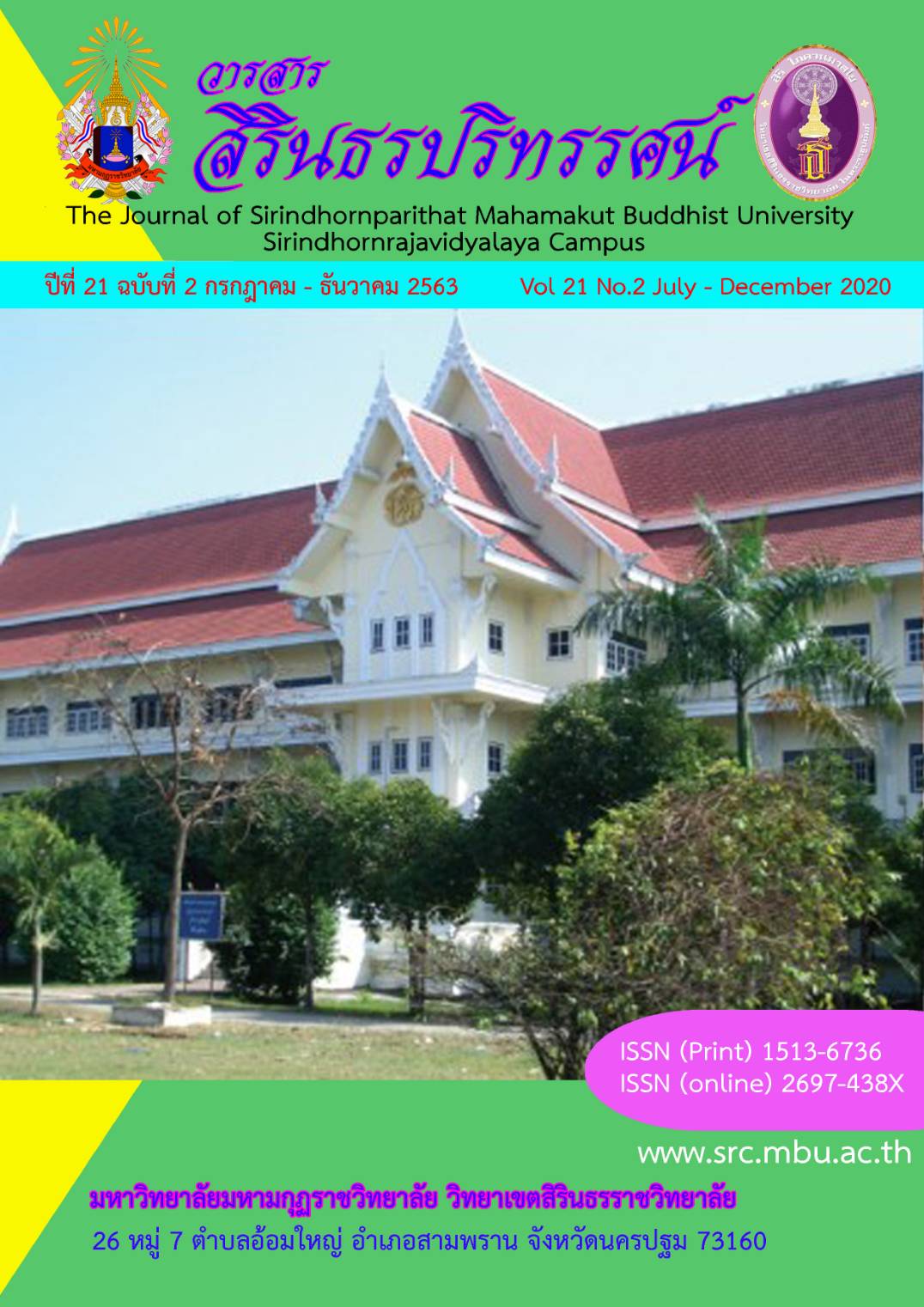The Use of Problem-Based Learning Focusing on Dhamma to Promote English Reading Comprehension
Keywords:
Problem-based Learning (PBL), Reading comprehension, Dhamma, WatsutthajindaAbstract
The purposes of this study were 1) to explore students’ satisfaction towards learning English through Problem-based Learning (PBL); 2) to compare the post-test mean score of English reading comprehension of grade seven students who have learned through Problem-based Learning (PBL) with the pre-test mean score, and 3) to compare the post-test mean score of English reading comprehension of grade seven students who have learned through Problem-based Learning (PBL) with the criteria of 60%. The samples used in this study were 35 students studying in grade seven, in the second semester of the 2018 academic year at Watsutthajinda School, Muang District, Nakhon Ratchasima. They were selected by cluster sampling. The research instruments consisted of a research questionnaire consisting of ten questions and English reading comprehension test consisting of 35 multiple choices questions. The questionnaire was used to explore students’ satisfaction and the English reading comprehension test was used to assess students’ English proficiency after learning English through Problem-based Learning (PBL). Statistics used in this study were Mean, Standard Deviation, and Dependent T-Test.
The results of the study showed that:
- Students were very highly satisfied with learning English through the Problem-based Learning (PBL) focusing on Dhamma.
- The post-test mean score of English reading comprehension of the students learning English through the problem-based-learning (PBL) focusing on Dhamma was higher than the pre-test mean score at the level of .01 statistical significance.
- The post-test mean score of English reading comprehension of the students learning English through the problem-based-learning (PBL) focusing on Dhamma was higher than the criteria of 60%.
References
Barrows, H. S. (2000). Problem-Based Learning applied to medical education. Springfield, Illinois: Southern Illinois University Press.
Barrows, H., & A. C. Kelson. (1995). Problem-Based in secondary education and the Problem-Based Learning Institute. Springfield, Illinois: Southern Illinois University Press.
Barrows, H. S., & Tamblyn, R. M. (1980). Problem-Based Learning: An approach to medical education. New York: Springer Publication Company.
Bauer, K. G. (2002). A framework for assessing Problem-Based Learning: A pathway of better learning conference. Proceedings of Problem-Based Learning 2002, 16 June 2002 (p.54). University of Delaware, Delaware.
Bertalanfly, L. (1968). General systems theory. New York: Braziller.
Biggs, J. (2003). Teaching for quality learning at university. London: Open University Press.
Boonchum, P. (2018). English reading efficiency of non-English-major students via context clues reading drills. Journal of Community Development Research (Humanities and Social Sciences), 11(4), 118-125.
Brodeur, D. R. (2002). Problem-Based Learning in aerospace engineering education. Canada: Montréal Quebec.
Boud, D. (2013). Problem-Based Learning in education for the professions. Sydney: Higher Education Research and Development Society of Australasia.
Channuwong, S., Ruksat, S., & Ploychum, S. (2018). An integration of Buddhist teachings in stress management. Journal of Community Development Research (Humanities and Social Sciences), 11(4), 148-158.
Christmas H. (1997). The life and work and a collection of 63 sermons by Luangphor Wat Paknam, the most venerable Phramomgkolthepmuni. Bangkok: Technique.
Delisle, R. (1997). How to use Problem-Based Learning in the classroom. Alexandria, VA: Association for Supervision and Curriculum Development.
Hmelo-Silver, C. E. (2000). Knowledge recycling: Crisscrossing the landscape of educational psychology in a Problem-Based Learning course for pre-service teachers. Journal of Excellent College Teaching, 11, 41- 56.
Hombult, T.E., & Larsen, A.B. (2016). Interdisciplinary reaching motivation: An initiative for change in post-16 vocational education. Nordic Journal of Modern Language, 4(13), 67-82. Retrieved from https://munin.uit.no/handle/10037/14458.
Jitpranee, J., Lisec, A., & Songsirisak, P. (2020). Using the interdisciplinary approach to enhance students’ intercultural communication competence in the English language training program. Journal of Community Development Research (Humanities and Social Sciences), 13(4), 25-37.
Karnphanit, S. (1999). Comparison of L2 listening and reading comprehension by university students learning English in Korea. Foreign Language Annuals, 37, 82.
Krishnan, S. (2006). A study of Problem-Based Learning in first-year electrical engineering: student learning approaches and outcomes. Proceedings of the 17th Annual Conference of the Australasian Association for Engineering Education 2006, 16
January 2006 (p. 78). Auckland: Auckland University of Technology, New Zealand.
Longsombun, A. (2017). Comprehension instruction. White Plains, NY: Longman.
Phra Brahmagunabhorn (P.A. Payutto). (2015). Dictionary of Buddhism. Bangkok: Pet and Home.
Pamojjo, P. (2017). Gestures of the Buddha. Bangkok: Chulalongkorn University.
Schmidt, H. G. (1992). Foundations of Problem-Based Learning: Some Explanatory Notes. Medical Education, 27, 22 - 32.
Tirawanchai, K. (2007). The effects of three instructional conditions in text structures on upper elementary students’ reading comprehension and writing performance. Retrieved from the ERIC database.
Vanichakorn, N. (2003). Constructivism in English as a foreign language secondary classroom in Bangkok, Thailand. (Doctoral dissertation). University of Northern Colorado, Colorado.
Webber, E. (2015). Five-phases to PBL: MITA (Multiple Intelligences Teaching Approach) models for a redesigned higher education class. Problem-Based Learning: Educational innovation across disciplines. Singapore: Temasek Center for Problem Based Learning.
Wilkerson, L.A. (1996). Bridging Problem-Based Learning to higher education: Theory and practice. San Francisco: Jossey-Bass Publishers.
Downloads
Published
Issue
Section
License
บทความที่ได้รับการตีพิมพ์เป็นลิขสิทธิ์ของ มหาวิทยาลัยมหามกุฏราชวิทยาลัย วิทยาเขตสิรินธรราชวิทยาลัย
ข้อความที่ปรากฏในบทความแต่ละเรื่องในวารสารวิชาการเล่มนี้เป็นความคิดเห็นส่วนตัวของผู้เขียนแต่ละท่านไม่เกี่ยวข้องกับหาวิทยาลัยมหามกุฏราชวิทยาลัย วิทยาเขตสิรินธรราชวิทยาลัย และคณาจารย์ท่านอื่นๆในมหาวิทยาลัยฯ แต่อย่างใด ความรับผิดชอบองค์ประกอบทั้งหมดของบทความแต่ละเรื่องเป็นของผู้เขียนแต่ละท่าน หากมีความผิดพลาดใดๆ ผู้เขียนแต่ละท่านจะรับผิดชอบบทความของตนเองแต่ผู้เดียว




